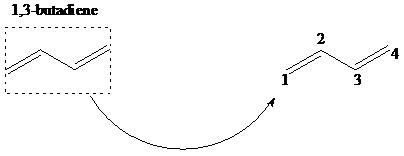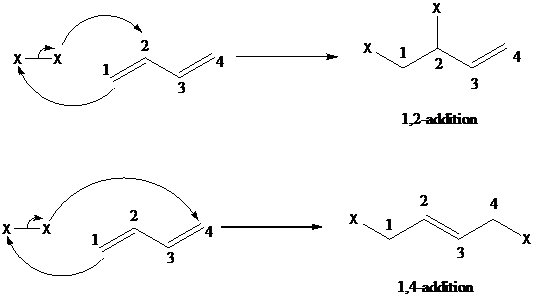
Concept explainers
Interpretation:
Detailed mechanism of hydrobromination via 1,2-addition and 1,4-addition mechanisms using peroxide promoted addition to 1,3-butadiene are to be written.
Concept introduction:
舧 Electrophiles are electron-deficient species, which has positive or partially positive charge. Lewis acids are electrophiles, which accept electron pair.
舧 Nucleophiles are electron rich species, which has negative or partially negative charge. Lewis bases are nucleophiles, which donate electron pair.
舧 Free radical is an atom, molecule, or ion that has an unpaired electron, which makes it highly chemically reactive.
舧 Substitution reaction: A reaction in which one of the hydrogen atoms of a hydrocarbon or a functional group is substituted by any other functional group is called substitution reaction.
舧 Elimination reaction: A reaction in which two substituent groups are detached and a double bond is formed is called elimination reaction.
舧 Addition reaction: It is the reaction in which unsaturated bonds are converted to saturated molecules by the addition of molecules.
舧 The reaction in which there is addition of hydrogen molecule is called hydrogenation reaction.
舧
舧 Hydrogenation with platinum as a catalyst is used to convert unsaturated carbohydrates to saturated hydrocarbons
舧 Oxidation of
舧 Ozonolysis helps convert the carbon–carbon double bonds to carbon–oxygen double bond (carbonyl compounds).
舧 Dimethyl sulfide is used as a reducing agent that decomposes the intermediate formed into the carbonyl group.
舧 NBS (nitro-bromo succinimide) is a special reagent used for bromination of allylic carbocations.
舧 Bromine replaces the hydrogen attached to the carbon adjacent to the carbon bearing double bond.
舧 This method of using NBS can produce allylic bromides without bromine reacting with the double bond.
舧 Dehydration of a primary alcohol in the presence of a mineral acid like concentrated sulfuric acid results in the formation of alkene via E2 elimination
舧 The 1,2–addition to a diene is addition of an electrophile to the carbon designated as 1 and a nucleophile to the carbon designated as 2. The positions of carbons as 1 and 2 are not according to the IUPAC numbering of the molecule, but as a conjugated diene molecule. 1,4-addition results in addition of hydrogen to the carbon designated as 1 and a halogen to the carbon designated as 4. The mechanism of 1,2 addition and 1,4-addition of hydro halogenation is given below.


舧 Organic peroxides are used in free radical chain reactions in the initiation steps.
Want to see the full answer?
Check out a sample textbook solution
Chapter 13 Solutions
Organic Chemistry
- Treatment of cyclohexene with iodobenzene under the conditions of the Heck reaction might be expected to give 1-phenylcyclohexene. The exclusive product, however, is 3-phenylcyclohexene. Account for the formation of this product.arrow_forwardpredict the product of the Diels-Alder reaction below, taking stereochemistry into account if relevantarrow_forwardDimethyl azodicarboxylate takes part in a DielsAlder reaction as a dienophile. Write the structure of the cycloaddition product of this molecule with 1,2-dimethylenecyclohexane. Knowing that this compound is formed under mild conditions, explain what favors reactivity in a Diels-Alder reaction over diene and dienophile structures.arrow_forward
- Determine all of the products obtained from the addition of HCl to the 1,3-diene. Once determined, draw a mechanism that accounts for the formation of every product. Then, Identify and account for the formation of the major adduct/or adducts under these conditions assuming that the reaction is conducted under thermodynamic conditions.arrow_forwardAddition of HBr to 3,3-dimethyl-1-butene gives a mixture of two isomeric alkyl bromide products. Please daw structures for the two products, and give a mechanistic explanation for their formation.arrow_forwardreaction of either 3-bromo-1-butene or (Z) -1-bromo-2-butene with water under SN1 condition yields the same product explain whyarrow_forward
- Write a general rule that can be used to predict the major product of a Diels–Alder reaction between an alkene with an electron-withdrawing substituent and a diene with a substituent that can donate electrons by resonance depending on the location of the substituent on the diene.arrow_forwardWhen anthracene is added to the reaction of chlorobenzene with concentrated NaOH at 350 °C, an interesting Diels–Alderadduct of formula C20H14 results. The proton NMR spectrum of the product shows a singlet of area 2 around d 3 and abroad singlet of area 12 around d 7. Propose a structure for the product, and explain why one of the aromatic rings ofanthracene reacted as a dienearrow_forwardConversion of an alkene to a halohydrin and internal displacement of a halide ion by an alkoxide ion are both stereoselective. Use this information to demonstrate that the configuration of the alkene is preserved in the epoxide. As an illustration, show that reaction of cis-2-butene by this two-step sequence gives cis-2,3- dimethyloxirane (cis-2-butene oxide).arrow_forward
- Complete the following by drawing products for a and b, and also identify the diene and dienophile in each one.arrow_forwardA2 What is the inverse electron demand Diels–Alder reaction? Please pick a pair of a diene and a dienophile from the following dienes and dienophile that will undergo this type of reaction. Please show how this reaction works using Frontier Molecular Orbitals. What is the reaction product?arrow_forwardA conjugated diene with an even number of double bonds undergoes conrotatory ring closure underthermal conditions.arrow_forward

 Organic ChemistryChemistryISBN:9781305580350Author:William H. Brown, Brent L. Iverson, Eric Anslyn, Christopher S. FootePublisher:Cengage Learning
Organic ChemistryChemistryISBN:9781305580350Author:William H. Brown, Brent L. Iverson, Eric Anslyn, Christopher S. FootePublisher:Cengage Learning

